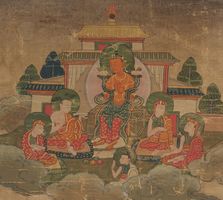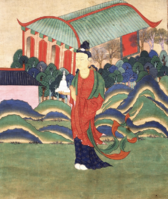Maitreya: Difference between revisions
No edit summary |
m (Text replacement - "{{Footer}}" to "") |
||
| (19 intermediate revisions by 4 users not shown) | |||
| Line 1: | Line 1: | ||
{{Person | {{Person | ||
| | |MainNamePhon=Maitreya | ||
|SortName=Maitreya | |||
|MainNameTib=བྱམས་པ་ | |||
|MainNameWylie=byams pa | |||
|bio=Known in Tibetan as the "Lord of Love" or the "Noble Loving One" {{TibIL|འཕགས་པ་བྱམས་པ།}} (Pakpa Jampa), the "Loving Protector" {{TibIL|བྱམས་པའི་མགོན་པོ་}} (Jampay Gonpo), in Chinese as 弥勒佛 (Mi Le Fo), Japanese as Miroku, and commonly as Maitreya throughout Asia and beyond. Maitreya is the bodhisattva called the "future Buddha" who resides in Tushita heaven until coming to the human realm to take the role of the next Buddha after Śākyamuni Buddha. According to tradition, Asaṅga received teachings from Maitreya and recorded them in the Five Dharma Treatises of Maitreya, which form the basis for buddha-nature teachings and the larger Yogācāra teachings in general. | |||
The list of five is: Ornament of Clear Realization (Abhisamayālaṃkāra, mngon rtogs rgyan, 現觀莊嚴論); Ornament for the Mahāyāna Sūtras (Mahāyānasūtrālaṃkāra, theg pa chen po mdo sde rgyan, 大乘莊嚴經論); Differentiation of the Middle and the Extremes (Madhyāntavibhāga, dbus mtha' rnam 'byed, 辨中邊論頌); Differentiation of Phenomena and Their Nature (Dharmadharmatāvibhāga, chos dang chos nyid rnam 'byed, 辨法法性論); and The Mahāyāna Treatise of the Highest Continuum (Ratnagotravibhāga Mahāyānottaratantraśāstra, theg pa chen po rgyud bla ma'i bstan bcos, 分別寶性大乘無上續論). | |||
|images=File:Maitreya teaching in Tushita.jpg{{!}}[https://www.himalayanart.org/items/65861 Himalayan Art Resources] | |||
File:Screen Shot 2018-06-20 at 3.54.38 PM.png | |||
File:Screen Shot 2018-06-20 at 3.54.12 PM.png | |||
|DeityFormType=Specific | |||
|DeityType=Bodhisattva | |||
|BdrcLink=http://tbrc.org/link?RID=P6118 | |||
|BdrcPnum=6118 | |||
|HarLink=https://www.himalayanart.org/pages/maitreya/index.html | |||
|DeityAppearance=Peaceful | |||
|DeityGender=Male | |||
|DeityGroup=nye ba'i sras chen brgyad | |||
|HasDrlPage=Yes | |HasDrlPage=Yes | ||
|HasLibPage=Yes | |HasLibPage=Yes | ||
|HasBnwPage=Yes | |HasBnwPage=Yes | ||
| | |MainNameDev=मैत्रेय | ||
|MainNameSkt=Maitreya | |MainNameSkt=Maitreya | ||
|AltNamesWylie='phags pa byams pa; byams pa'i mgon po; mgon po byams pa | |AltNamesWylie='phags pa byams pa; byams pa'i mgon po; mgon po byams pa; ma pham pa | ||
|AltNamesTib= | |AltNamesTib=འཕགས་པ་བྱམས་པ་; བྱམས་པའི་མགོན་པོ་; མགོན་པོ་བྱམས་པ་; མ་ཕམ་པ་ | ||
|AltNamesOther=Ajita | |||
|TeacherOf=Asaṅga | |TeacherOf=Asaṅga | ||
|BiographicalInfo=Maitreya is often called the future Buddha and is the bodhisattva who resides in Tushita heaven until coming to the human realm to take the role of the next Buddha after Shakyamuni Buddha. | |BiographicalInfo=Maitreya is often called the future Buddha and is the bodhisattva who resides in Tushita heaven until coming to the human realm to take the role of the next Buddha after Shakyamuni Buddha. | ||
|BnwShortPersonBio=Known in Tibetan as the "Lord of Love" or the "Noble Loving One" འཕགས་པ་བྱམས་པ། (Pakpa Jampa), the "Loving Protector" བྱམས་པའི་མགོན་པོ་ (Jampay Gonpo), in Chinese as 弥勒佛 (Mi Le Fo), Japanese as Miroku, and commonly as Maitreya throughout Asia and beyond. Maitreya is the bodhisattva called the "future Buddha" who resides in Tushita heaven until coming to the human realm to take the role of the next Buddha after Śākyamuni Buddha. According to tradition, Asaṅga received teachings from Maitreya and recorded them in the Five Dharma Treatises of Maitreya, which form the basis for buddha-nature teachings and the larger Yogācāra teachings in general. | |||
|BnwShortPersonBio= | |||
|BnwPersonEssay=#The Ornament of Clear Realization - Sanskrit: अभिसमयालंकार-नाम-प्रज्ञापारमितोपदेशशास्त्रकारिका (abhisamayālaṃkāra-nāma-prajñāpāramitopadeśaśāstrakārikā) - Tibetan: ཤེས་རབ་ཕྱི་ཕ་རོལ་ཏུ་ཕྱིན་པའི་མན་ངག་གི་བསྟན་བཅོས་མངོན་པར་རྟོགས་པའི་རྒྱན་ཞེས་བྱ་བའི་ཚིག་ལེའུར་བྱས་པ། (shes rab phyi pha rol tu phyin pa'i man ngag gi bstan bcos mngon par rtogs pa'i rgyan zhes bya ba'i tshig le'ur byas pa). "Ngon par Tokpay Gyen" for short (mngon par rtogs pa'i rgyan). Translated by Gomi Chime (Go mi 'chi med) and Loden Sherab (Blo ldan shes rab). Dege 3786, shes phyin, ka 1b1-13a7. P 5184, sher phyin, ka 1a1-15b3 (vol.88, p.1-8). Narthang 3957, sher phyin, ka 1a1-14a1. | |BnwPersonEssay=#The Ornament of Clear Realization - Sanskrit: अभिसमयालंकार-नाम-प्रज्ञापारमितोपदेशशास्त्रकारिका (abhisamayālaṃkāra-nāma-prajñāpāramitopadeśaśāstrakārikā) - Tibetan: ཤེས་རབ་ཕྱི་ཕ་རོལ་ཏུ་ཕྱིན་པའི་མན་ངག་གི་བསྟན་བཅོས་མངོན་པར་རྟོགས་པའི་རྒྱན་ཞེས་བྱ་བའི་ཚིག་ལེའུར་བྱས་པ། (shes rab phyi pha rol tu phyin pa'i man ngag gi bstan bcos mngon par rtogs pa'i rgyan zhes bya ba'i tshig le'ur byas pa). "Ngon par Tokpay Gyen" for short (mngon par rtogs pa'i rgyan). Translated by Gomi Chime (Go mi 'chi med) and Loden Sherab (Blo ldan shes rab). Dege 3786, shes phyin, ka 1b1-13a7. P 5184, sher phyin, ka 1a1-15b3 (vol.88, p.1-8). Narthang 3957, sher phyin, ka 1a1-14a1. | ||
#The Ornament of the Mahayana Sutras - Sanskrit: महायानसूत्रालंकारकारिका (mahāyānasūtrālaṃkārakārikā); Tibetan: ཐེག་པ་ཆེན་པོ་མདོ་སྡེའི་རྒྱན་ཞེས་བྱ་བའི་ཚིག་ལེའུར་བྱས་པ། (theg pa chen po mdo sde'i rgyan zhes bya ba'i tshig le'ur byas pa). Revised by Parahita and Sajjana, Translated into Tibetan by Śākyasimha, Loden Sherab and Paltseg. Dege 4020, sems tsam, phi 1a1-39a4. P 5521, sems tsam, phi 1-43b3 (vol.108, p.1-19). Narthang phi 1a1-38a2. Kinsha 3520, phi 1b1 (p.1-2-1). | #The Ornament of the Mahayana Sutras - Sanskrit: महायानसूत्रालंकारकारिका (mahāyānasūtrālaṃkārakārikā); Tibetan: ཐེག་པ་ཆེན་པོ་མདོ་སྡེའི་རྒྱན་ཞེས་བྱ་བའི་ཚིག་ལེའུར་བྱས་པ། (theg pa chen po mdo sde'i rgyan zhes bya ba'i tshig le'ur byas pa). Revised by Parahita and Sajjana, Translated into Tibetan by Śākyasimha, Loden Sherab and Paltseg. Dege 4020, sems tsam, phi 1a1-39a4. P 5521, sems tsam, phi 1-43b3 (vol.108, p.1-19). Narthang phi 1a1-38a2. Kinsha 3520, phi 1b1 (p.1-2-1). | ||
| Line 22: | Line 35: | ||
#The Sublime Continuum - The Treatise on the Ultimate Continuum of the Mahāyāna - Sanskrit: महायानोत्तरतन्त्रशास्त्र-रत्नगोत्र-विभाग (mahāyānottaratantraśāstra-ratnagotra-vibhāga). Tibetan: ཐེག་པ་ཆེན་པོ་རྒྱུད་བླ་མའི་བསྟན་བཅོས། (theg pa chen po rgyud bla ma'i bstan bcos). Chinese: 究竟一乘寶性論 (jiu jing yi ch'eng bao xing lun). Translated into Tibetan by Sajjana and Loden Sherab. Dege 4024, sems tsam, phi 54b1-73a7. P 5525, sems tsam, phi 54b7-74b6 (vol.108, p.24-32). Narthang phi 48b3-69a3. Kinsha 3524, phi 64b1 (p.33-3-1). | #The Sublime Continuum - The Treatise on the Ultimate Continuum of the Mahāyāna - Sanskrit: महायानोत्तरतन्त्रशास्त्र-रत्नगोत्र-विभाग (mahāyānottaratantraśāstra-ratnagotra-vibhāga). Tibetan: ཐེག་པ་ཆེན་པོ་རྒྱུད་བླ་མའི་བསྟན་བཅོས། (theg pa chen po rgyud bla ma'i bstan bcos). Chinese: 究竟一乘寶性論 (jiu jing yi ch'eng bao xing lun). Translated into Tibetan by Sajjana and Loden Sherab. Dege 4024, sems tsam, phi 54b1-73a7. P 5525, sems tsam, phi 54b7-74b6 (vol.108, p.24-32). Narthang phi 48b3-69a3. Kinsha 3524, phi 64b1 (p.33-3-1). | ||
|PosBuNayDefProv=Definitive | |PosBuNayDefProv=Definitive | ||
|BuNayDefProvComplex=No | |||
|PosAllBuddha=Yes | |PosAllBuddha=Yes | ||
| | |BuNayWheelTurnComplex=No | ||
|BuNayYogaMadhyaComplex=No | |||
|BuNayZhenRangComplex=No | |||
|BuNayVehiclesComplex=No | |||
|BuNayAnalyticMeditComplex=No | |||
|BuNayEmptyLuminComplex=No | |||
|IsInGyatsa=No | |IsInGyatsa=No | ||
}} | }} | ||
<noinclude>[[Category:Indian authors sanskrit names]]</noinclude> | |||
Latest revision as of 14:39, 5 June 2024
| MainNamePhon | Maitreya |
|---|---|
| MainNameTib | བྱམས་པ་ |
| MainNameWylie | byams pa |
| MainNameDev | मैत्रेय |
| MainNameSkt | Maitreya |
| SortName | Maitreya |
| AltNamesTib | འཕགས་པ་བྱམས་པ་ · བྱམས་པའི་མགོན་པོ་ · མགོན་པོ་བྱམས་པ་ · མ་ཕམ་པ་ |
| AltNamesWylie | 'phags pa byams pa · byams pa'i mgon po · mgon po byams pa · ma pham pa |
| AltNamesOther | Ajita |
| bio | Known in Tibetan as the "Lord of Love" or the "Noble Loving One" འཕགས་པ་བྱམས་པ། (Pakpa Jampa), the "Loving Protector" བྱམས་པའི་མགོན་པོ་ (Jampay Gonpo), in Chinese as 弥勒佛 (Mi Le Fo), Japanese as Miroku, and commonly as Maitreya throughout Asia and beyond. Maitreya is the bodhisattva called the "future Buddha" who resides in Tushita heaven until coming to the human realm to take the role of the next Buddha after Śākyamuni Buddha. According to tradition, Asaṅga received teachings from Maitreya and recorded them in the Five Dharma Treatises of Maitreya, which form the basis for buddha-nature teachings and the larger Yogācāra teachings in general.
The list of five is: Ornament of Clear Realization (Abhisamayālaṃkāra, mngon rtogs rgyan, 現觀莊嚴論); Ornament for the Mahāyāna Sūtras (Mahāyānasūtrālaṃkāra, theg pa chen po mdo sde rgyan, 大乘莊嚴經論); Differentiation of the Middle and the Extremes (Madhyāntavibhāga, dbus mtha' rnam 'byed, 辨中邊論頌); Differentiation of Phenomena and Their Nature (Dharmadharmatāvibhāga, chos dang chos nyid rnam 'byed, 辨法法性論); and The Mahāyāna Treatise of the Highest Continuum (Ratnagotravibhāga Mahāyānottaratantraśāstra, theg pa chen po rgyud bla ma'i bstan bcos, 分別寶性大乘無上續論). |
| BiographicalInfo | Maitreya is often called the future Buddha and is the bodhisattva who resides in Tushita heaven until coming to the human realm to take the role of the next Buddha after Shakyamuni Buddha. |
| TeacherOf | Asaṅga |
| BDRC | http://tbrc.org/link?RID=P6118 |
| Himalayan Art Resources | https://www.himalayanart.org/pages/maitreya/index.html |
| IsInGyatsa | No |
| BnwShortPersonBio | Known in Tibetan as the "Lord of Love" or the "Noble Loving One" འཕགས་པ་བྱམས་པ། (Pakpa Jampa), the "Loving Protector" བྱམས་པའི་མགོན་པོ་ (Jampay Gonpo), in Chinese as 弥勒佛 (Mi Le Fo), Japanese as Miroku, and commonly as Maitreya throughout Asia and beyond. Maitreya is the bodhisattva called the "future Buddha" who resides in Tushita heaven until coming to the human realm to take the role of the next Buddha after Śākyamuni Buddha. According to tradition, Asaṅga received teachings from Maitreya and recorded them in the Five Dharma Treatises of Maitreya, which form the basis for buddha-nature teachings and the larger Yogācāra teachings in general. |
| PosBuNayDefProv | Definitive |
| PosAllBuddha | Yes |
| Other wikis |
If the page does not yet exist on the remote wiki, you can paste the tag |



